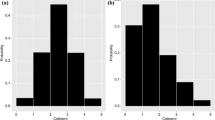Abstract
Withdrawing from a longitudinal investigation is a common problem in epidemiological research. This paper describes a nonparametric method, based on a bootstrap approach, for assessing whether dropouts are missed at random. The basic idea is to compare scores of dropouts and non-dropouts at different assessments using a weighted nonparametric test statistic.
A Monte Carlo investigation evaluates the comparative power of the test to violations from populations normality, using three commonly occurring distributions. The test proposed here is more powerful than the parametric counterpart under distributions with extreme skews.
The method is applied to a longitudinal community-based study investigating mental disorders. It is found that dropouts did not differ from the other subjects with respect to two psychological variables, although chi-square tests gave some other impressions.
Similar content being viewed by others
References
Berk, R. A. (1983). An introduction to sample selection bias in sociological data. American Sociological Review 48: 386-398.
Bridge, P. D. & Sawilowsky, S. S. (1999). Increasing Physicians' awareness of the impact of statistics on research outcomes: comparative power of the t-test and Wilcoxon rank sum test in small samples applied research. Journal of Clinical Epidemiology 52: 229-235.
Curran, D., Bacchi, M., Hsu Schmitz, S. F. H., Molenberghs, G. & Sylvester, R. J. (1998). Identifying the types of missingness in quality of life data from clinical trials. Statistics in Medicine 17: 739-756.
Derogatis, L. R. (1977). SCL-90-R, administration, scoring, and procedures manual for the R(evised) version. Johns Hopkins University, School of Medicine.
Diggle, P. J. (1989). Testing for random dropouts in reapeated measurements data. Biometrics 45: 1255-1258.
Efron, B. & Tibshirani, R. J. (1993). An Introduction to the Bootstrap. New York: Chapman and Hall.
Fisher, R. A. (1932). Statistical Methods for Research Workers. Edinburgh: Oliver and Boyd.
Franke, G. H. (1995). SCL-90-R: Die Symptom-Check-Liste von Derogatis-Deutsche Version. Göttingen: Beltz Test Gesellschaft.
Franz, M., Lieberz, K., Schmitz, N. & Schepank, H. (1999). A decade of spontaneous long-term course of psychogenic impairment in a community populations sample. Social Psychiatry and Psychiatric Epidemiology 34: 651-656.
Goldberg, D. P., Cooper, B., Eastwod, M. R., Kedward, H. B. & Shepherd, M. (1970). A standardized psychiatric interview for use in community surveys. British Journal of Preventive & Social Medicine 24: 18-23.
Hodges, J. & Lehmann, E. L. (1956). The efficiency of some nonparametric competitors of the t test. Annals of Mathematical Statistics 27: 324-335.
Johnson, N. J. (1978). Modified t tests and confidence intervals for asymmetrical populations. Journal of the American Statistical Association 73: 536-544.
Kenward, M. G. (1998). Selection models for repeated measurements with nonrandom dropout: an illustration of sensitivity. Statistics in Medicine 17: 2723-2732.
Listing, J. & Schlittgen, R. (1998). Tests if dropouts are missed at random. Biometrical Journal 40: 929-935.
Little, J. A. & Rubin, D. B. (1987). Statistical Analysis With Missing Data. New York: Wiley.
Little, R. J. A. (1995). Modeling the drop-out mechanism in repeated-measures studies. Journal of the American Statistical Association 90: 1112-1121.
Molenberghs, G., Goetghebeur, E. J. T., Lipsitz, S. R. & Kenward, M. G. (1999). Nonrandom missingness in categorical data: Strengths and limitations. The American Statisticia 53: 110-118.
Mooney, C. (1995). Bootstrap**: a non-parametric approach to statistical inference. Hillsdale, NJ: Sage.
Randles, R. H. & Wolfe, D. A. (1979). Introduction to the theory of nonparametric statistics. New York: Wiley.
Robins, J. M. (1997) Non-response models for the analysis of non-monotone non-ignorable missing data. Statistics in Medicine 16: 21-38.
SAS Institute Inc. (1994). SAS/STAT User's Guide, Version 6. Cary, NC: SAS Institute Inc.
Schepank, H. (1987). Epidemiology of Psychogenic Disorders. The Mannheim Study-Results of a Field Survey in the Federal Republic of Germany. Berlin Heidelberg New York: Springer-Verlag.
Schmitz, N., Kruse, J., Heckrath, C., Alberti, L. & Tress, W. (1999). Diagnosing mental disorders in primary care: the General Health Questionnaire (GHQ) and the Symptom Check List (SCL-90-R) as screening instruments. Social Psychiatry and Psychiatric Epidemiology 34: 360-366.
Tippett, L. H. C. (1931). The Methods of Statistics. London: Williams and Norgate.
Author information
Authors and Affiliations
Rights and permissions
About this article
Cite this article
Schmitz, N., Franz, M. A Bootstrap Method To Test If Study Dropouts Are Missing Randomly. Quality & Quantity 36, 1–16 (2002). https://doi.org/10.1023/A:1014357821705
Issue Date:
DOI: https://doi.org/10.1023/A:1014357821705




